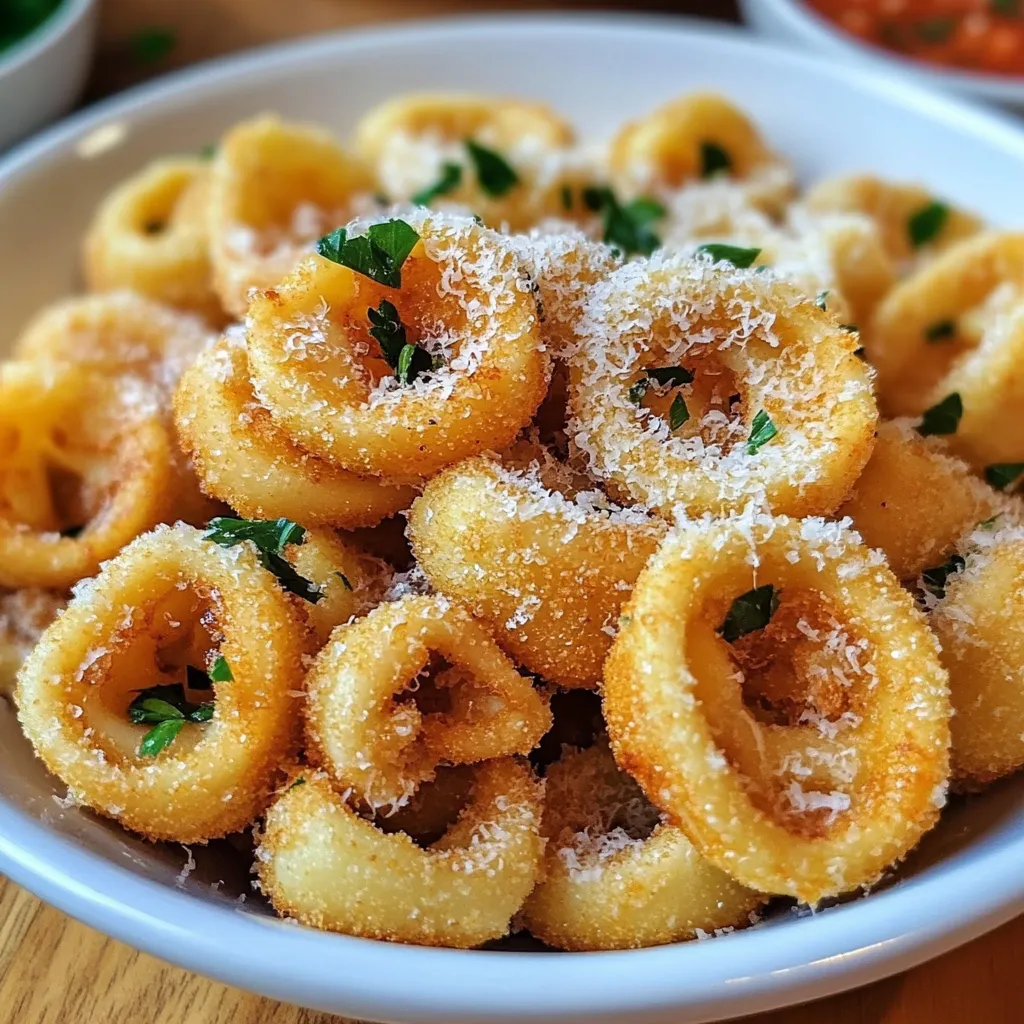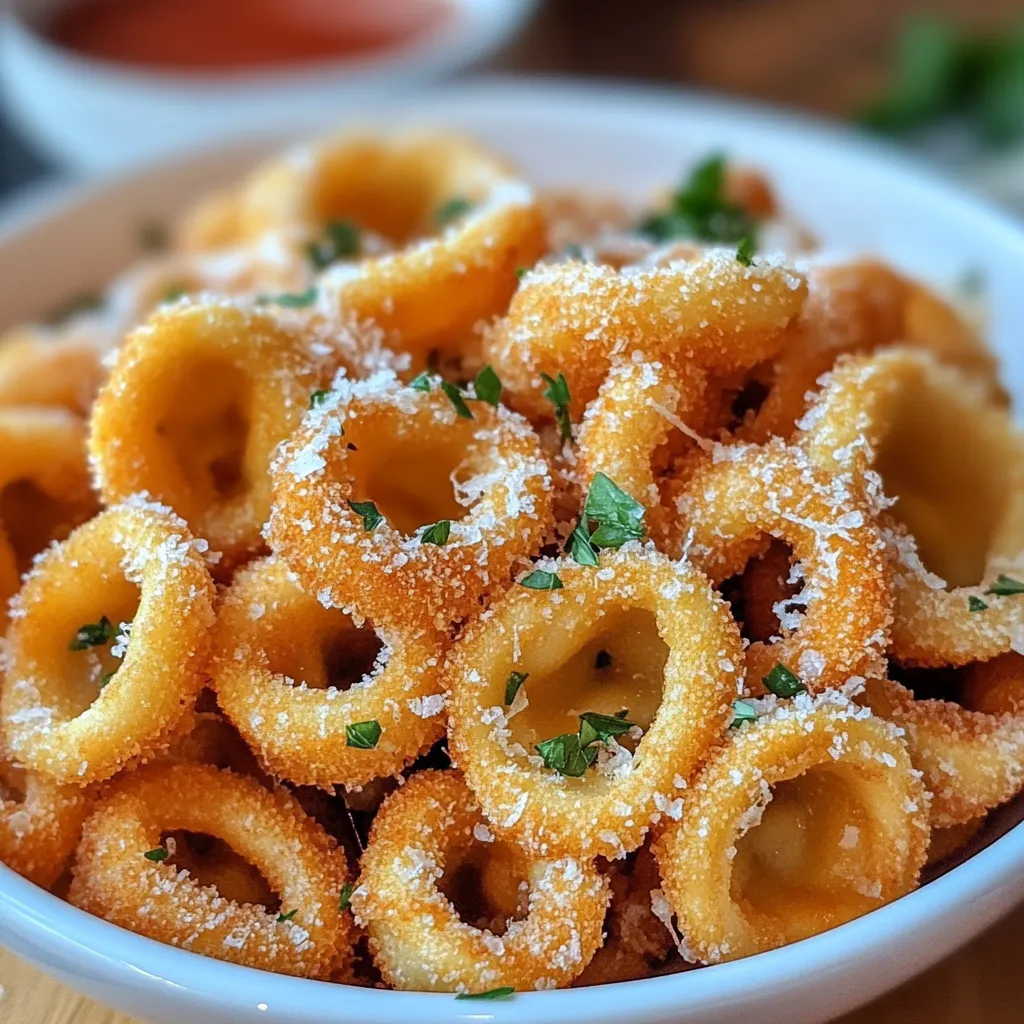 Save
Save
Delicate pasta parcels transform beneath a golden armor of herbed Parmesan crust, creating an extraordinary symphony of textures and flavors in every bite. These Crispy Parmesan Fried Tortellini elevate humble refrigerated pasta through the alchemical process of precise coating and careful frying. Each morsel delivers the perfect contrast between shatteringly crisp exterior and tender, cheese-filled interior—creating an irresistible appetizer that disappears from platters with remarkable speed while earning appreciative murmurs from even the most discerning guests.
I discovered this inspired transformation during a particularly memorable Italian dinner party when I sought something beyond traditional antipasti to welcome my guests. The first time these golden morsels appeared from my kitchen, conversation momentarily ceased before erupting into enthusiastic praise. My typically reserved father-in-law, a man of few compliments, actually asked for the recipe—a rare honor indeed. What began as culinary experimentation has evolved into our most-requested party appetizer, proving that sometimes the most memorable dishes emerge not from complex techniques but from reimagining familiar ingredients in unexpected ways.
Essential Elements
- Refrigerated tortellini: Cheese-filled varieties provide classic flavor; spinach or mushroom offer intriguing alternatives
- Panko breadcrumbs: Japanese-style creates superior crispness; Italian-seasoned varieties add additional herbs
- Parmesan cheese: Parmigiano-Reggiano provides exceptional depth; freshly grated ensures proper incorporation
- Garlic powder: Provides aromatic foundation; granulated garlic offers more intense flavor
- Black pepper: Freshly cracked creates superior complexity; white pepper substitutes for visual purity
- Eggs: Farm-fresh provides richer color and binding; room temperature whips more efficiently
- All-purpose flour: Creates essential preliminary coating; tipo 00 offers delicate Italian authenticity
- Olive oil: Extra virgin provides fruity foundation; light varieties offer higher smoke point
- Fresh parsley: Italian flat-leaf provides classic garnish; adds visual brightness and herbaceous finish
- Marinara sauce: Homemade offers superior dipping experience; high-quality jarred provides convenience
Culinary Creation
- Pasta Preparation
- Begin by bringing a generously salted pot of water to a vigorous boil—the water should taste like the Mediterranean Sea. Add refrigerated tortellini, stirring gently to prevent sticking, and cook just until they float to the surface, typically 2-3 minutes. This precise timing is critical, as you want them slightly undercooked, since they'll continue cooking during the frying process. Drain immediately and spread on a clean kitchen towel, allowing excess moisture to evaporate while cooling slightly. This careful preparation creates the perfect foundation for your crispy coating, preventing unwanted sogginess or steam from compromising the final texture.
- Coating Construction
- Prepare your breading station with strategic organization—flour in one shallow bowl, beaten eggs in another, and the panko mixture in a third. This assembly-line approach ensures efficient workflow. For the panko mixture, combine breadcrumbs with freshly grated Parmesan cheese, garlic powder, and freshly ground black pepper, mixing thoroughly to create uniform distribution of flavors. The ratio of breadcrumbs to cheese is crucial—equal parts create the ideal balance of crispness and savoriness, while the garlic and pepper provide aromatic depth without overwhelming the delicate pasta.
- Precise Dredging
- Working with dry hands for flour and breadcrumbs, and wet hands for eggs, begin the coating process. Roll each tortellini first in flour, tapping gently to remove excess—this critical initial layer creates the foundation to which egg will adhere. Next, dip into beaten egg, allowing excess to drip back into the bowl, ensuring thin, even coverage. Finally, transfer to the panko-Parmesan mixture, pressing gently to adhere the coating to all surfaces, especially around the edges and in the center depression of each tortellini. This methodical triple-coating technique ensures perfect crust development during frying.
- Golden Transformation
- Heat olive oil to precisely 350°F in a heavy-bottomed skillet, creating the ideal temperature for developing golden crispness without excessive oil absorption. The proper oil depth should reach halfway up the tortellini when added. Working in small batches to prevent crowding and temperature drops, carefully add the coated pasta to the hot oil. Fry for approximately 2-3 minutes per side until achieving a magnificent golden-brown crust. This patient, watchful frying process ensures even coloration and exceptional crispness while maintaining the integrity of the tender pasta within.
- Finishing Flourish
- Transfer the golden treasures to a paper towel-lined plate, arranging them in a single layer rather than stacking, which would compromise their crisp exteriors. Season immediately with a light sprinkle of flaky sea salt while still hot, allowing the crystals to adhere to the oil-kissed surface. Garnish with freshly chopped parsley just before serving, adding vibrant color contrast and a final herbaceous note that brightens the rich, savory flavors. Serve warm with warmed marinara in a small dipping bowl alongside, creating the perfect balance of crispy, cheesy pasta and tangy tomato acidity.
 Save
Save
My closest friend initially expressed skepticism about frying what was already perfectly good pasta. The first time she sampled these crispy morsels at a gathering, she immediately sought me out with wide eyes, saying, "I never would have thought tortellini could be improved upon, but this is positively addictive!" Her reaction confirmed what I'd discovered through experimentation—that sometimes the most successful culinary innovations come not from complex techniques but from applying unexpected cooking methods to familiar ingredients. The transformation of soft pasta into crispy, portable bites creates an entirely new experience that honors the original while creating something distinctly more engaging.
Creative Variations
Transform this versatile appetizer to accommodate various preferences while maintaining its essential character. Experiment with different tortellini fillings—four-cheese, spinach, mushroom, or even meat-filled varieties each create distinct flavor profiles within the same crispy exterior. Consider incorporating dried herbs like oregano, basil, or Italian seasoning into the breadcrumb mixture for aromatic depth. For heat enthusiasts, add red pepper flakes or cayenne to the coating. Create international variations by incorporating spices like smoked paprika, curry powder, or za'atar, paired with complementary dipping sauces. Those seeking lighter options might use an air fryer rather than traditional oil-frying, reducing fat while maintaining exceptional crispness.
Serving Suggestions
This versatile appetizer welcomes thoughtful presentation that enhances its appeal. For elegant cocktail parties, serve upright in small glasses with dipping sauce in the bottom, creating vertical visual interest on buffet tables. Consider a variety of dipping options—classic marinara, creamy garlic aioli, pesto, or spicy arrabbiata—allowing guests to customize their experience. For casual gatherings, place on wooden boards alongside complementary antipasti like marinated olives, roasted red peppers, and fresh mozzarella. When serving as a main course appetizer, accompany with a simple arugula salad dressed with lemon vinaigrette, providing refreshing contrast to the rich, crispy pasta.
Practical Preservation
While these crispy delights reach their pinnacle of perfection immediately after frying, practical options exist for advance preparation. Complete the coating process up to four hours ahead, arranging prepared tortellini on a parchment-lined baking sheet refrigerated until ready to fry. For fully prepared leftovers, reheat in a 350°F oven for 5-7 minutes until warmed through and re-crisped rather than microwaving, which would compromise their signature texture. Though best enjoyed fresh, these can be stored in airtight containers for up to two days, recognizing that each reheating will gradually diminish some of their initial textural perfection.
 Save
Save
The first time I created these Crispy Parmesan Fried Tortellini, I was simply seeking an innovative appetizer that would surprise and delight my guests. What I discovered was a dish that delivers more satisfaction with less effort than many of my more complex recipes. Each time I serve them, I'm reminded that cooking at its most joyful is about transformation—how simple ingredients become extraordinary through thoughtful preparation, how familiar foods take on new dimensions through unexpected techniques, and how the humble can become elevated through the magic of contrast, whether in texture, temperature, or flavor.
Common Questions About Cooking
- → Can I use any type of tortellini for this recipe?
- Yes! You can use cheese, spinach, or meat-filled tortellini. All work great and just add different flavors to the final dish.
- → Can I make these ahead of time?
- You can prepare them a few hours ahead. Reheat in a 375°F oven for 5-7 minutes to crisp them back up before serving.
- → What's the best dipping sauce for fried tortellini?
- Marinara is classic, but try garlic butter, pesto, ranch, or even a spicy arrabbiata sauce for different flavor experiences.
- → Can I air fry these instead of pan frying?
- Absolutely! Air fry at 380°F for 8-10 minutes, flipping halfway through. Spray with a little oil for best results.
- → How do I store leftovers?
- Store in an airtight container in the fridge for up to 3 days. Reheat in the oven rather than microwave to maintain crispiness.
